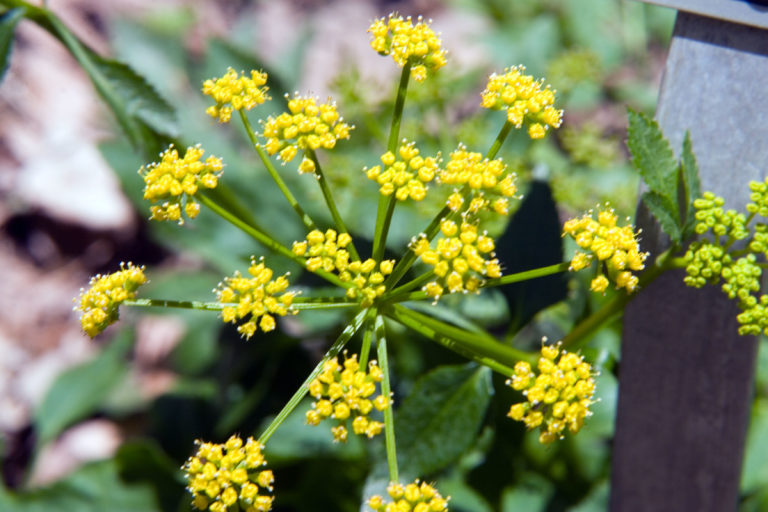Zizea aurea, or Golden Alexander, is an herbaceous perennial found in piedmont and mountain counties of NC but is much more widespread in the midwest, north central and northeastern states. It consists of 30-inch, branching, erect, reddish, ridged stems which, like others in the carrot family, are hollow between the nodes. The foliage is lacy, divided, and aromatic. Flowers are bright yellow and numerous, and seedheads turn purple in fall, adding further visual interest. It is easily grown in consistantly moist to wet but well-drained soils, in full sun to partial shade, and is not fussy about pH.This is a short-lived perennial, but persists in the garden or meadow by seeding out. Golden Alexanders are an excellent addition to a wildflower garden because they provide accessible nectar to many beneficial insects with short mouthparts during the spring and early summer, when such flowers are relatively uncommon (Illinoiswildflower.into). It is also a larval host for Black Swallowtail and Ozark Swallowtail butterflies.
NURSERY HOURS
Wednesday: 10-4 Thursday: 10-6 Friday-Saturday: 10-4 Sunday: 12-4
Zizia aurea

Key Info
Scientific Name: Zizia aurea (L.) W.D.J. Koch
Common Names: Golden Alexanders, Golden Zizia
Family Names: Apiaceae (Carrot Family)
Plant Type: Herbaceous perennial
Flower Color: Yellow
Additional Info
Habit: Erect perennial consisting of several smooth shiny stems with light green vertical lines and occasional lateral stems arising from the basal rosette. The root system consists of a dense cluster of coarse fibrous roots.
Height: 2.5'
Spread: 1.5' - 2'
Soil Conditions: Moist, acid to alkaline pH, sandy or sandy-clay soils, rocky or gravelly soil.
Leaves: Leaves are alternately arranged. Basal leaves are trifoliate (a diagnostic character).The lower compound leaves are twice-pinnate and have long petioles. These become shorter towards the top, and the upper leaves are pinnate, or once divided, with 3 or 5 leaflets. Leaflets are oval or lance-shaped, 3 inches by 2 inches wide, occasioally with 1-2 cleft lobes, with fine serrations on the margins. The petiole ends in a sheath that surrounds the stem. The leaves are light purple in fall.
Flowers (or reproductive structures: Tiny yellow flowers are arranged in flat or slightly rounded compound umbels at the ends of the upper stems. Each compound umbel is about 2-3 inches across, and consists of about 12 umbellets. The central flower of each umbellet is sessile, or nearly so (a diagnostic character). Each flower is about 1/8 inch across with 5 incurved yellow petals, an insignificant calyx, a pistil, and 5 stamens. The blooming period occurs from late spring to early summer, and lasts about 1 month. There is no floral scent.
Fruit: The seeds are oblong and flattened, but not winged (a diagnostic character), with several lighter-colored longitudinal ridges. Each flower produces a single tiny, oblong fruit containing two seeds. The fruit changes color as the year goes on. In the fall both the leaves and the fruit turn purple.
Natural Distribution: Golden alexander occurs in moist habitat: moist prairies, openings in moist to mesic woodlands, powerline clearances in wooded areas, and abandoned fields.
USDA Hardiness Zone: 3 to 8
USDA Wetland Indicator Status in NC: FAC
Pollination: This plant is capable of self-pollination but is also pollinated by a number of insects.
Wildlife Connections: Larval host for Black Swallowtail and Ozark Swallowtail whose caterpillars will feed on its leaves and flowers. Zizia is visited by many kinds of insects seeking pollen or nectar, especially short-tongued bees, wasps, flies, and beetles but long-tongued bees such as bumblebees and cuckoo bees also visit the flowers, as do some small butterflies and true bugs. See Illinoiswildflowers.info for more!
Propagation: By division, or planting stratified seeds in the fall.
